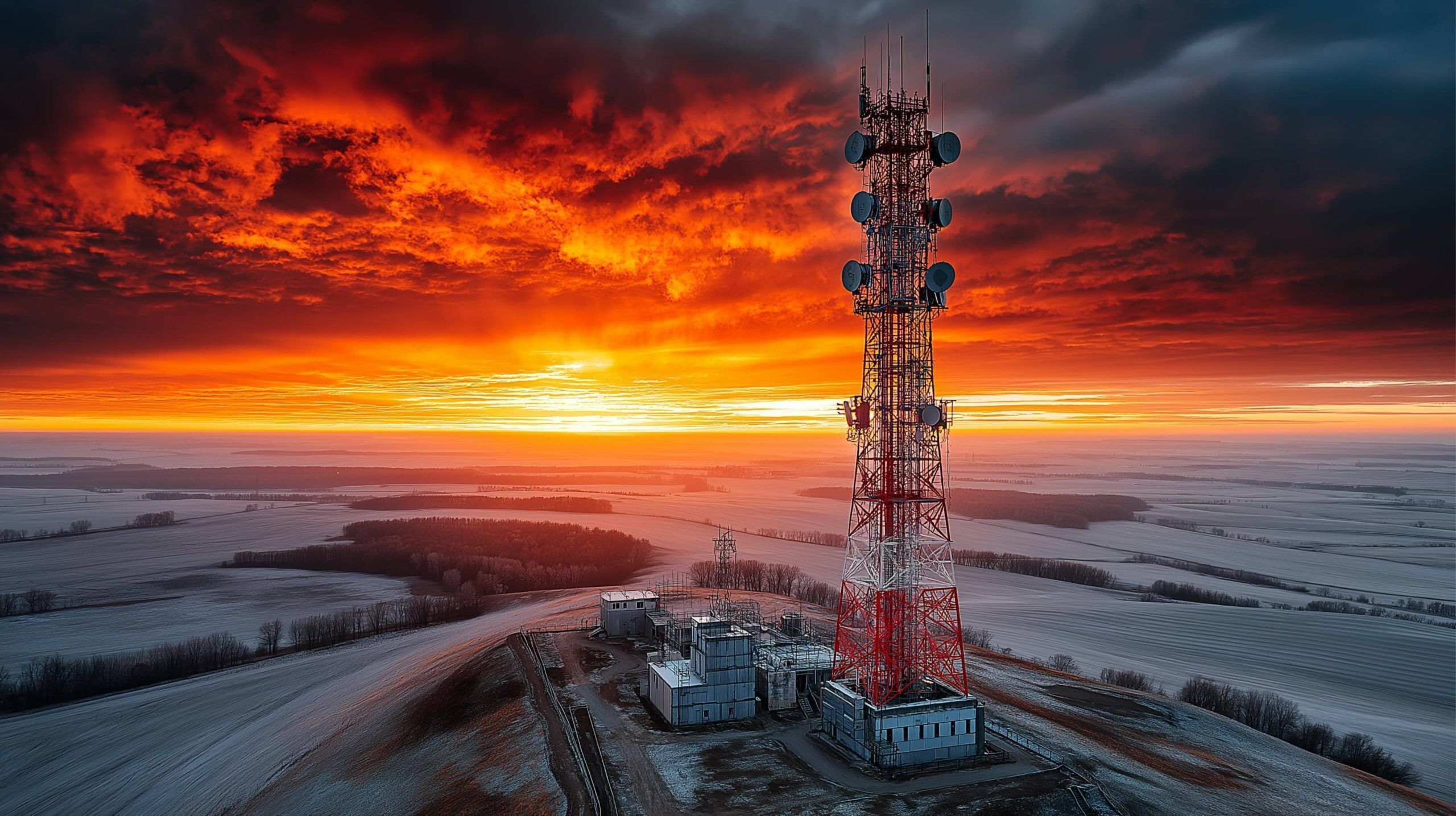- In late 2024 Digital Transformation Minister Mykhailo Fedorov announced a two-year 5G pilot in three cities—Lviv first, with Kyiv and Odesa testing through 2025—as a step toward a full 5G rollout by 2030.
- In November 2024 Ukraine auctioned spectrum in the 2100, 2300, and 2600 MHz bands, raising ₴2.8 billion (~$67.7 million) and awarding five lots to Kyivstar, Vodafone Ukraine, and lifecell with licenses requiring 1,500 new base stations in two years and 500 in the first year, plus six months to restore service in liberated areas.
- The three major operators scrapped domestic roaming charges, enabling free roaming on each other’s networks when a subscriber’s own signal is down, supported by thousands of diesel generators and backup batteries.
- By February 2024 median mobile download speeds were about 21 Mbps, with roughly 79% of Ukrainians online and 20% offline due to war related outages, while 4G coverage expanded rapidly.
- In September 2024 lifecell and Datagroup-Volia completed a merger for $524 million, and in October 2024 the EBRD and IFC announced a $435 million financing package to modernize networks, forming a converged group led by Xavier Niel’s NJJ Holding with Horizon Capital and Mykhaylo Shelemba, totaling about 10 million mobile subscribers and 4 million broadband homes passed.
- The merged lifecell-Datagroup-Volia group plans to deploy 10,000+ km of fiber, add 1,000+ new 4G/5G base stations, upgrade towers, and bolster cybersecurity, backed by EBRD/IFC loans.
- SpaceX Starlink served 47,000 terminals by end-2023, and in mid-2025 Kyivstar is set to launch Direct-to-Cell satellite service starting with satellite SMS by late 2025 and expanding to broadband and voice by 2026.
- Ukraine’s Strategy for Electronic Communications through 2030 targets 98% of Ukrainians with mobile internet and universal broadband, and seeks EU-aligned regulations including roaming rules and cross-border fiber routes to improve resilience.
- Kyivstar spent over ₴3.3 billion on network resiliency upgrades and installed thousands of generators and lithium batteries, while Vodafone Ukraine invested over ₴2 billion by early 2024 to repair more than 900 damaged sites.
- In December 2023 a Russian state-backed Sandworm attack on Kyivstar knocked out services for about 24 million mobile users for days, and in 2024 CERT-UA recorded 4,315 cyber incidents, a 70% rise from 2023, prompting joint cyber monitoring centers with the SBU and support from EU and US partners.
Mobile & Broadband Services: 5G Takes Off and Connectivity Expands
Ukraine’s mobile market is charging ahead with next-gen technology even as war rages. In late 2024, Digital Transformation Minister Mykhailo Fedorov announced a 5G pilot project in three cities as a “key step towards the full launch of 5G in Ukraine” by 2030 kyivindependent.com. The two-year pilot, beginning in 2024, will test 5G’s compatibility with military networks – a crucial consideration during an active conflict kyivindependent.com kyivindependent.com. “5G is capable of transmitting data 10 times faster than 4G, so it creates new opportunities… at ultra-high speeds,” Fedorov noted, emphasizing the resilience benefits even “despite the pressures of Russia’s full-scale war” kyivindependent.com. While the pilot cities were not immediately named, officials later confirmed Lviv would be first to trial 5G, with broader tests in Kyiv and Odesa planned through 2025 samenacouncil.org samenacouncil.org. Major operators Kyivstar, Vodafone Ukraine, and lifecell are gearing up for this 5G era after years of delay, even collaborating with the National Cybersecurity Center to ensure no interference with defense systems samenacouncil.org.
Meanwhile, 4G coverage is rapidly expanding. The government set an ambitious target to raise 4G population coverage from 65% to 91% within three years developingtelecoms.com developingtelecoms.com. Despite wartime disruptions, operators have rolled out LTE to rural and highway areas. In November 2024, the telecom regulator (NCEC) auctioned new spectrum in the 2100, 2300, and 2600 MHz bands, raising ₴2.8 billion (~$67.7 million) developingtelecoms.com developingtelecoms.com. Kyivstar, Vodafone, and lifecell collectively bought five spectrum lots under licenses requiring 1,500 new base stations in two years – including 500 sites in the first year – and mandating rapid restoration of communications in de-occupied territories within 6 months developingtelecoms.com developingtelecoms.com. These conditions tie network expansion to Ukraine’s liberation of occupied lands, ensuring civilians get reconnected quickly. The new licenses also demand improved mobile coverage along national highways developingtelecoms.com. Kyivstar’s CEO Oleksandr Komarov hailed the auction as evidence that “the war does not stop investments… [it] is an important step in the development of Ukraine’s electronic communications” developingtelecoms.com developingtelecoms.com.
In practice, Ukrainian operators have shown unprecedented cooperation to keep people online. All domestic roaming charges were scrapped early in the invasion – the three major operators let customers hop on each other’s networks for free if their own signal is down euronews.com euronews.com. This national roaming pact, coupled with thousands of diesel generators and backup batteries deployed at cell sites, helped maintain coverage through scheduled blackouts and energy attacks euronews.com euronews.com. By early 2024, median mobile download speeds hovered around 21 Mbps (far below the 52 Mbps global average) freedomhouse.org, as heavy wartime network usage and power outages sometimes caused congestion or outages freedomhouse.org. Still, roughly 79% of Ukrainians were online by Feb 2024, with internet user numbers growing despite the war, leaving about 20% offline freedomhouse.org freedomhouse.org. Mobile data remains affordable – Ukraine has among Eastern Europe’s lowest cost per GB, a trend that continued in 2024 as operators competed to retain subscribers ts2.tech. On the fixed broadband side, however, the war has hit hard: sector revenue fell ~30% year-on-year by late 2024, as damage to infrastructure and population displacement shrank the market brdo.com.ua. Many home internet users have shifted to mobile or satellite links in hard-hit regions, underscoring the critical role of mobile networks during the conflict.
Industry & Infrastructure: Major Investments, Mergers and Rebuilding Efforts
People inspect the wreckage of a TV tower in Kharkiv, destroyed by a Russian missile on April 22, 2024. Telecom infrastructure has sustained over $2 billion in damage during the war euronews.com euronews.com.
In 2024, Ukraine’s telecom industry saw historic investments and consolidation, signaling confidence in its post-war future. In October 2024, the European Bank for Reconstruction and Development (EBRD) and IFC (World Bank Group) announced a joint $435 million financing package to modernize and expand networks across Ukraine ebrd.com ebrd.com. This represents the largest wartime foreign direct investment in Ukraine’s telecom sector. The funds back an ambitious merger: mobile operator lifecell and broadband provider Datagroup-Volia have combined to form a new converged telecom group ebrd.com ebrd.com. French telecom investor Xavier Niel’s NJJ Holding leads this venture with a majority stake, partnering with U.S.-based Horizon Capital and Ukrainian executive Mykhaylo Shelemba (now CEO of the merged group) ebrd.com ebrd.com. The deal, completed in September 2024 for $524 million developingtelecoms.com, creates a “telecom champion” with 10 million mobile subscribers and 4 million broadband homes passed developingtelecoms.com. It’s a landmark bet on Ukraine: “The time to invest in Ukraine is now,” said Niel upon sealing the acquisition, expressing confidence that rebuilding the country’s digital infrastructure will unlock its economic potential developingtelecoms.com developingtelecoms.com.
The merged lifecell-Datagroup-Volia entity is leveraging its new scale to harden networks and roll out better services. Backed by EBRD/IFC loans (partially guaranteed by the EU and France), the group plans to upgrade mobile towers, extend fiber broadband, and bolster cybersecurity defenses ebrd.com ebrd.com. EBRD Vice President Mark Bowman noted the telecom sector’s crucial role in Ukraine’s resilience, calling this investment “essential to Ukraine’s welfare and economic resilience since the war began” ebrd.com ebrd.com. Indeed, the war has inflicted an estimated $1.9 billion in direct damage and $750 million in losses to telecom infrastructure as of 2023 ebrd.com ebrd.com. Rebuilding is costly – Ukraine’s government estimates about $4.7 billion (over 10 years) is needed to fully restore and upgrade telecom networks countrywide euronews.com euronews.com. The lifecell merger and international financing will jumpstart this recovery: the new group pledges to deploy 10,000+ km of fiber and 1,000+ new 4G/5G base stations, bringing high-speed internet to millions of Ukrainians, including in war-torn areas ebrd.com ebrd.com.
Other major players are also shoring up their operations. Kyivstar, the market leader (owned by VEON), is pursuing an IPO on the NASDAQ by late 2025 – a bold move to raise capital for expansion developingtelecoms.com developingtelecoms.com. VEON’s CEO cited an “unwavering commitment to building Ukraine’s digital infrastructure”, noting the firm has committed $1 billion through 2027 to expand 4G coverage, deploy more backup power systems, and prepare for 5G developingtelecoms.com developingtelecoms.com. In 2023–24 Kyivstar installed thousands of generators and lithium batteries to keep its network running through blackouts freedomhouse.org freedomhouse.org. It spent over ₴3.3 billion ($90 million) on network resiliency upgrades, including fortifying cell sites against power loss and cyber threats developingtelecoms.com developingtelecoms.com. Rival Vodafone Ukraine (owned by NEQSOL/Azerbaijan) likewise invested heavily – over ₴2 billion by early 2024 – to repair 900+ damaged sites and strengthen coverage euronews.com euronews.com. Smaller ISPs and regional operators have struggled, with around 720 providers suffering “substantial losses” and ~100 facing bankruptcy due to wartime destruction euronews.com euronews.com. This has prompted consolidation and support from the government and larger telcos to maintain services in hard-hit communities.
International tech companies are also partnering in Ukraine’s connectivity push. SpaceX’s Starlink satellite service has been a literal lifesaver – by end of 2023 Ukraine was operating 47,000 Starlink terminals, one of the highest usage rates in the world euronews.com. These units kept critical infrastructure and civilians online during grid blackouts and in frontline zones with no cell coverage euronews.com freedomhouse.org. In mid-2025, Kyivstar struck a groundbreaking deal with Starlink to develop “Direct-to-Cell” (D2C) satellite service, making Ukraine one of Europe’s first to trial satellites connecting directly to standard mobile phones developingtelecoms.com developingtelecoms.com. The partnership will start by enabling satellite SMS and messaging nationwide by late 2025, then expand to broadband and voice via low-Earth orbit satellites by 2026 developingtelecoms.com developingtelecoms.com. “The first phase – messaging on platforms like WhatsApp, Signal, SMS – will go live by end of 2025,” said Kyivstar CEO Komarov, heralding full D2C service by mid-2026 developingtelecoms.com developingtelecoms.com. This Starlink-Kyivstar initiative, supported by Ukraine’s Ministry of Digital Transformation, exemplifies the blending of cellular and satellite tech to guarantee connectivity under any circumstances. Ukraine is effectively becoming a testbed for innovative telecom solutions born out of wartime necessity.
Regulatory Changes & Market Developments
Ukraine’s government and regulator have been proactive in adapting the telecom sector to wartime and EU-integration demands. In late 2023, the Cabinet approved a Strategy for Electronic Communications through 2030 that prioritizes “stable connection, 5G rollout, and nationwide gigabit internet” as pillars of post-war recovery unn.ua ground.news. The strategy aims for 98% of Ukrainians to have high-quality mobile internet and universal broadband by 2030, aligning with EU Digital Single Market standards biz.liga.net. It also calls for creating conditions to scale IoT and 5G, and synchronizing Ukrainian telecom regulations with European Union norms biz.liga.net. Integration with Europe is well underway: Ukraine joined the EU’s “roam like at home” initiative on an interim basis, and in 2024 discussions advanced to make free EU roaming for Ukrainians permanent developingtelecoms.com. Cross-border network links with EU countries have been bolstered to reroute internet traffic away from conflict zones – for instance, new fiber routes through Poland, Slovakia, and Romania now ensure Ukraine’s internet access is no longer solely dependent on paths through Russia or the Black Sea, improving resilience freedomhouse.org freedomhouse.org.
Domestically, the National Communications regulator introduced measures to help operators cope with war impacts. Fees for spectrum and licenses were waived or reduced for networks in combat areas, and mobile number portability rules were relaxed to let displaced citizens switch providers more easily. The regulator’s November 2024 spectrum auction itself was notable not just for raising funds, but for its stringent rollout conditions tying licenses to coverage in liberated territories developingtelecoms.com developingtelecoms.com. This reflects a policy of “build back better”: any time the army frees a town, telecom crews are expected to restore service within months, aided by government coordination. Since September 2023, the Ministry of Digital Transformation has been formally tasked with leading these restoration efforts, uniting operators and local authorities to quickly rebuild cell towers and repair fiber in reclaimed areas freedomhouse.org freedomhouse.org. By May 2024, the ministry had set up 730+ “Invincibility Points” – public hubs where citizens under bombardment can charge devices and access free satellite internet and Wi-Fi freedomhouse.org freedomhouse.org. These policies underscore how telecom is treated as vital infrastructure, critical for civilian morale and emergency services during the conflict.
Notably, cybersecurity regulation has also tightened. In 2024, telecom firms worked closely with Ukraine’s cyber authorities (SSSCIP and SBU) to implement new standards after several hacking incidents. The government enhanced requirements for telcos to report breaches and harden their core networks, and partnered with EU agencies to train telecom staff in cyber defense darkreading.com. Legislation was drafted to classify telecom infrastructure as part of the national critical infrastructure, bringing it under military protection and cybersecurity mandates. These steps were catalyzed by the dramatic events of late 2023, when Ukraine suffered one of the worst telecom cyberattacks in history.
Cyberattacks and Conflict: Defending Ukraine’s Digital Lifelines
While missiles and shells pound physical infrastructure, Ukraine’s telecom networks have also faced relentless cyber onslaughts. In December 2023, Russian state-backed hackers launched a devastating cyberattack on Kyivstar, the country’s largest telecom operator. The attack infiltrated Kyivstar’s core IT systems months in advance and, on Dec. 12, unleashed a destructive wiper that knocked out services for 24 million mobile users for several days reuters.com reuters.com. Illia Vitiuk, cyber chief of Ukraine’s SBU security service, said the breach “completely destroyed the core of a telecoms operator”, wiping out thousands of servers and critical databases reuters.com. “This attack is a big warning… that no one is untouchable,” Vitiuk told Reuters, noting that even a well-resourced private company was blindsided despite significant cybersecurity investments reuters.com reuters.com. The SBU attributed the operation to the GRU’s notorious Sandworm hacking unit and revealed the intruders had lurked in Kyivstar’s network for at least 6–7 months reuters.com reuters.com. During that time, they potentially had access to call data, user locations, and could intercept messages reuters.com. The December assault caused real-world chaos: millions of Ukrainians suddenly lost mobile service, ATM machines went offline (many use Kyivstar SIMs for connectivity), and even air-raid sirens in some regions failed to trigger due to the network outage reuters.com reuters.com. Fortunately, Ukraine’s military communication was unaffected – the army relies on separate secure systems (often Starlink and radio) – but the incident underscored the high stakes of cyber warfare in telecom.
Ukrainian and international experts scrambled to help Kyivstar restore service within days reuters.com. Since then, telecom operators have stepped up cyber defenses with government support. All three mobile operators formed joint cyber monitoring centers with the SBU to share threat intelligence. Western partners like the EU Cyber Rapid Response Team and U.S. Cyber Command have also been assisting Ukraine in fortifying telco networks darkreading.com. These efforts are critical as attacks surge: CERT-UA recorded 4,315 cyber incidents in 2024, a 70% jump from 2023, mostly attributed to Russian intelligence units imi.org.ua. Many attacks target telecom and energy grids simultaneously, seeking to sever Ukrainians’ connectivity. Despite this, Ukraine’s networks have shown remarkable resilience. As Stanislav Prybytko of the Digital Transformation Ministry observed, operators keep teams in “continuous repair mode,” sometimes fixing the same bombed fiber line or tower eight times over after repeated shelling developingtelecoms.com developingtelecoms.com. Field engineers have bravely traversed minefields and front-line areas (often escorted by soldiers) to repair communications in liberated towns euronews.com euronews.com. In one heroic account, a Vodafone engineer in besieged Mariupol kept refueling generators for base stations for 10 days straight under fire, until the city fell developingtelecoms.com. Such stories illustrate how telecom personnel have become “hidden front-line fighters,” keeping civilians connected and informed.
Crucially, redundancy and decentralization have been Ukraine’s saviors. When power was knocked out across cities in winter attacks, backup generators kept 80% of cell towers in Kharkiv operational, even as that city’s electrical grid lay in ruins euronews.com euronews.com. And when terrestrial networks have failed, satellite internet stepped in – not just Starlink’s tens of thousands of terminals, but also VSAT links and even high-altitude balloon trials by tech volunteers. The government reports that thanks to overlapping mobile coverage (and the no-cost national roaming between operators), only about 12% of households have completely lost mobile service at any given time during the war euronews.com. Still, occupied areas present a communications blackout: “The first thing the Russians do after occupying cities is deprive people of communication,” Prybytko noted euronews.com euronews.com. Russian forces have systematically destroyed telecom equipment or carted it off to Russia in seized towns euronews.com euronews.com. This makes post-liberation restoration even more urgent – and costly – as operators must rebuild from zero in places like Mariupol or Melitopol once those are freed.
Despite the immense challenges, Ukraine’s telecom sector is not only surviving – it’s innovating under fire. The phrase “decentralization saves us” has become a mantra, referring to the way diverse technologies (fiber, mobile, satellite), multiple operators, and international support have created a more robust connectivity fabric than pre-war euronews.com euronews.com. For example, in frontline villages where cables can’t be safely laid, providers set up Wi-Fi hotspots beaming from military-grade Starlink units, allowing residents to check email or contact family for a few minutes a day freedomhouse.org freedomhouse.org. In larger cities, telecom companies have opened hundreds of free charging and Wi-Fi centers (“Invincibility Points”), often co-located with emergency services, to ensure no matter how long the power is out, people can periodically get online freedomhouse.org. This resilience has prompted Ukrainian officials to boldly declare that Russia’s attempts to digitally isolate Ukraine have “failed to break us.” By 2025, Ukraine is doubling down on becoming a digital nation despite the war – rolling out 5G pilots, laying fiber to the most remote hamlets, and even planning to become Europe’s “digital hub” in the longer term ground.news kmu.gov.ua.
Outlook: Post-2024 Recovery and the Road Ahead
As 2025 progresses, Ukraine’s internet and telecom sector stands at a pivotal crossroads of peril and opportunity. The toll of war is staggering – over 4,300 mobile towers destroyed and 30,000 km of fiber cut by Russian attacks euronews.com freedomhouse.org. Yet, the response has been equally extraordinary. International aid and investments are pouring in to not just rebuild, but upgrade Ukraine’s connectivity. The EU and allied nations view Ukraine’s telecom reconstruction as vital for the country’s economic revival and security; projects are underway to fund 10-year rebuild plans integrating the latest technologies and cybersecurity by design euronews.com euronews.com. For consumers, this will mean a leapfrog to modern services – ubiquitous 4G/5G coverage, affordable high-speed internet even in rural areas, and new satellite-mobile hybrid offerings ensuring that even a future disaster can’t knock Ukrainians offline.
Expert observers note that Ukraine’s telecom wartime experience could inform other countries’ infrastructure resilience. “Developing an industry during wartime is a challenge, but not a reason to put life on hold,” said Kyivstar’s Komarov, reflecting on lessons learned developingtelecoms.com developingtelecoms.com. The fact that Ukraine held a successful spectrum auction in the middle of war, and that telecom companies are planning IPOs and billion-dollar investments, signals strong confidence in the sector’s future developingtelecoms.com developingtelecoms.com. Regulators are aligning laws with European standards, from data protection to 5G security, in anticipation of EU membership. And importantly, Ukraine’s people have embraced digital tools – from the government’s Diia mobile app for public services to widespread use of messaging apps and social media for war news – making reliable telecom service as essential as food or water.
In summary, Ukraine’s internet and telecommunications sector in 2024–2025 is a story of remarkable resilience and rapid evolution. Consumers are beginning to see tangible improvements like pilot 5G service and wider 4G coverage, even as they cope with outages and disruptions. The industry is consolidating and attracting foreign capital on an unprecedented scale, positioning itself for a post-war boom. Authorities are actively modernizing the legal and strategic framework to integrate with Europe and incentivize innovation. All the while, engineers and cybersecurity teams literally battle in trenches (physical and digital) to keep the country connected under the most challenging conditions imaginable. As one EBRD official put it, Ukraine’s connectivity has become “essential to [the] economic resilience” of the nation ebrd.com – and by extension, a key front in its fight for survival and future prosperity. Despite the bombs and hackers, Ukraine is building a stronger, faster, more unified telecom network that not only withstands the shocks of war, but is poised to drive the country’s recovery in the years ahead.
Sources: Official news releases, Ukrainian government statements, telecom company reports, and international media coverage from 2024–2025 were used in compiling this report, including EBRD ebrd.com ebrd.com, the Kyiv Independent kyivindependent.com kyivindependent.com, Euronews euronews.com euronews.com, Reuters reuters.com reuters.com, Freedom House freedomhouse.org freedomhouse.org, and other expert analyses. These provide a factual basis for the described developments in Ukraine’s telecom sector during the period.




